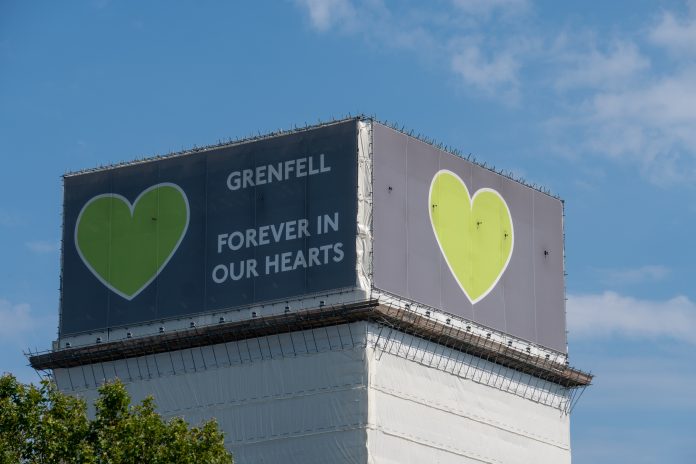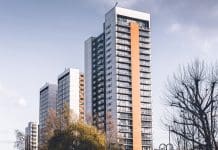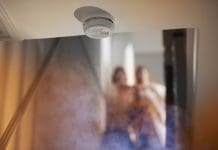Phase 1 of the Grenfell Tower Inquiry report has blamed ACM cladding for the fire spreading and recommends every owner/manager of high-rise residential buildings be required by law to provide their local fire service with information about the design
Following the tragic Grenfell Tower fire, in the early hours of Wednesday 14 June 2017, the Grenfell inquiry report (Phase 1) has been released.
A fire broke out in the kitchen of Flat 16 Grenfell Tower, a high-rise residential building in North Kensington, West London. Grenfell Tower was owned by the Royal Borough of Kensington and Chelsea (RBKC) and managed by the Royal Borough of Kensington and Chelsea Tenant Management Organisation (the TMO).
Firefighters from the London Fire Brigade (LFB) attended the fire and within minutes of their arrival had extinguished the fire within the kitchen of Flat 16, but by that time the fire had already escaped into the cladding where they were unable to fight it successfully.
Once established within the cladding the fire spread rapidly up the outside of the building. Within 20 minutes a vertical column of flame had reached the top of the building on the east side from where it progressed around the rest of the structure, so that within a few hours it had engulfed almost the whole of the building.
The core participants and the experts who gave evidence in Phase 1 have suggested many steps which in their view can and should be taken to improve the safety of those who live in high-rise buildings and should therefore form the subject of immediate recommendations. However, they exhibited a wide divergence of views.
The recommendations set out below are based entirely on the evidence heard in relation to the particular issues that were investigated in Phase 1 and on the findings and conclusions reach in the Phase 1 report.
Sir Martin Moore-Bick, chairman of the Grenfell Tower Inquiry, said: “It is important that any recommendations I make at this, or indeed any other, stage should be based firmly on the facts that have emerged from the evidence obtained by the Inquiry in the course of its investigations. I also think it important that they command the support of those who have experience of the matters to which they relate.
“Recommendations that are not grounded in the facts are of no value and recommendations that do not command the support of those who are experts in the field are likely to be ignored and, if not ignored, risk giving rise to adverse unintended consequences.”
Use of combustible materials
Surveys undertaken since the fire have established that external wall materials similar to those used on Grenfell Tower have been used on over 400 other high-rise residential buildings around the country.
From the evidence in Phase 1, two very important matters have come to light: first, that in its origin the fire at Grenfell Tower was no more than a typical kitchen fire; second, that the fire was able to spread into the cladding as a result of the proximity of combustible materials to the kitchen windows.
It is unnecessary to recommend that panels with polyethylene cores on the exterior of high-rise buildings be removed as soon as possible and replaced with materials of limited combustibility because it is accepted that that must be done. It is essential that it be done as quickly as possible and concern has been voiced publicly, most recently by the House of Commons Communities and Local Government Select Committee, about the apparently slow rate of progress in carrying out the work.
Fire and rescue services: knowledge and understanding of materials used in high-rise buildings
The risk of fire of the kind that occurred at Grenfell Tower may be low, but knowledge is the key to proper planning and effective training.
Sir Martin Moore-Bick therefore recommends:
- The owner and manager of every high-rise residential building be required by law to provide their local fire and rescue service with information about the design of its external walls together with details of the materials of which they are constructed and to inform the fire and rescue service of any material changes made to them;
- That all fire and rescue services ensure that their personnel at all levels understand the risk of fire taking hold in the external walls of high-rise buildings and know how to recognise it when it occurs
Emergency calls
Even allowing for the fact that the control room was operating under great pressure, it is clear that in many cases control room operators (CROs) failed to handle Fire Survival Guidance (FSG) calls in an appropriate or effective way. It is therefore recommended that:
- That the LFB’s policies be amended to draw a clearer distinction between callers seeking advice and callers who believe they are trapped and need rescuing;
- The LFB provide regular and more effective refresher training to CROs at all levels, including supervisors;
- That all fire and rescue services develop policies for handling a large number of FSG calls simultaneously.
Further recommendations
- Provide local fire and rescue services with up-to-date plans in both paper and electronic form of every floor of the building identifying the location of key fire safety systems;
- Ensure that buildings contain a premises information box, the contents of which must include a copy of the up-to-date floor plans and information about the nature of any lift intended for use by the fire and rescue services.
Evacuation
- The government to develop national guidelines for carrying out partial or total evacuations of high-rise residential buildings, such guidelines to include the means of protecting fire exit routes and procedures for evacuating persons who are unable to use the stairs in an emergency, or who may require assistance (such as disabled people, older people and young children);
- Fire and rescue services develop policies for partial and total evacuation of high-rise residential buildings and training to support them
Debbie Dore, chief executive of APM, responded to the long-awaited public inquiry report: “This report is an important public document and we all need to ensure that the right lessons are learned. Our thoughts are with the families of the victims and the survivors on what will be a difficult day. “
“Although this report focuses on the immediate event of the fire, much has been done by professional bodies to look at the wider issue of building safety and, crucially, the culture issues which underpin the building and renovation of high rise and similar buildings are addressed.
“The Hackitt report (Building a Safer Future) set out three themes central to addressing building safety concerns. The first two highlight the need for improving both culture and competence across all aspects of building and construction. The third theme binds these two themes together, namely the required leadership and co-operation across professions and sectors.
“We continue to work in cooperation with other professional bodies through the Construction Industry Council to achieve these changes.”
Responding to the publication of Phase 1 of the Grenfell Tower Inquiry, a spokesman for the Kensington and Chelsea Tenant Management Organisation, said: “We welcome the recommendations and insight the inquiry report has provided regarding the response on the night of the tragic fire and renew our deepest sympathies to the bereaved, survivors and their families.
“We recognise that this report is a significant step towards ensuring nothing like this can ever happen again. We will now be contributing to Phase Two of the Inquiry, which will bring a greater understanding of the underlying causes of the fire.”
Phase 2 will involve a more detailed examination of certain aspects of the management of the LFB (in particular its understanding of modern methods of construction and of the way in which some of the materials currently in use behave when exposed to fire) and the steps that were taken to train its officers to respond to fires in high-rise buildings.
However, the evidence put before Sir Martin Moore-Bick in Phase 1 is already sufficient to demonstrate that a number of improvements can be made both in the way in which high-rise residential buildings are designed, constructed, approved and managed and in the way in which fire and rescue services respond to fires in such buildings.
Read the full report, by Sir Martin Moore-Bick here.

















